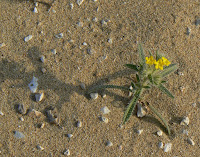This weekend, we visited the singing sand dunes, one of approximately 30 sites in the world where sound is produced from sand dunes naturally. The dunes themselves curve round in a semi circle, forming a natural desert amphitheatre.
where sound is produced from sand dunes naturally. The dunes themselves curve round in a semi circle, forming a natural desert amphitheatre.
They didn’t sing. Again. (This was our second trip). The first time their failure was blamed on recent rain, so we waited until a few weeks had gone by without rain, but to no effect.
Friends who have been previously have sworn blind that there was something to be heard. We tried to set the sound off by running, jumping and rolling down the dunes, but to no avail. Several times we thought we hear a low droning sound, only to look up and see aircraft.
The closest we came to success was not at the designated dunes, but several kilometres to the south-east of them. These were similar looking dunes, and as we ran down them we heard a deep zoom-zoom sound with each step. This was not a continuous sound, though, but a series of sounds, each individual sound caused by each individual footstep.
Noise from singing sand dunes, which have been reported in the Middle East for over 1500 years, have been described as “roaring, booming, squeaking, singing or musical” (Singing and booming sand dunes of California and Nevada). Qataris used to attribute these sounds to evil Djinns; similarly, Marco Polo, when he heard the sounds 700 years ago, blamed the sounds on evil spirits.
years, have been described as “roaring, booming, squeaking, singing or musical” (Singing and booming sand dunes of California and Nevada). Qataris used to attribute these sounds to evil Djinns; similarly, Marco Polo, when he heard the sounds 700 years ago, blamed the sounds on evil spirits.
There is still some controversy over how exactly the sand dunes produce the sound (see The troubled song of the sand dunes) . However, it is certain that for the sound to be heard the sand needs to be put into motion. When the singing is heard, the sounds’ vibrations can sometimes be felt reverberating through your body.
For singing to take place, the sand must also be extremely dry – even the presence of 0.1% moisture will reduce the effectiveness of the singing. This could explain why we heard nothing, as there has been heavy rain this year, and truffles are still growing in the desert.
Whether or not you hear any singing, there’s great fun to be had running down the sand dunes. the sand. In addition, you can see small lizards scamper along the surface of the dunes. Move towards them, and they’ll dive below the surface of the dunes. When there are no lizards, you can see the
When it is windy, you can also observe sand blowing off the back of the sand dunes, creating what appeared to be a lip of blowing sand – with blue sky showing beneath. The sand grains will settle on the back, contributing to the growth of the dune.
On the way to the singing sand dunes you’ll see thorny desert trees – and, at the moment, wild oats growing to the side of the road. Around the dunes you’ll also find small desert plants with thorny leaves and small, bright yellow flowers.
The area is very photogenic, and a great place to add rolling sand dunes to your photo collection. It’s worth staying until sunset, when the sun descends down over the dunes. You’ll also hear and maybe see some desert birds. And you might even hear those bloody sand dunes...
Also see:
The Singing Sand Dunes: directions
City-swallowing Sand Dunes
Singing and booming Sand Dunes of California and Nevada
The troubled song of the sand dunes
Qatar Visitor e-store (U.S.)
Qatar Visitor E-store (U.K.)
Find the best deal, compare prices and read what other travellers have to say about Qatar
Tags
Qatar Doha Middle East singing sand dunes
Friday, March 02, 2007
The Singing Sand Dunes
Posted by
Qatarguest
at
9:45 PM
![]()
Labels: places outside Doha


